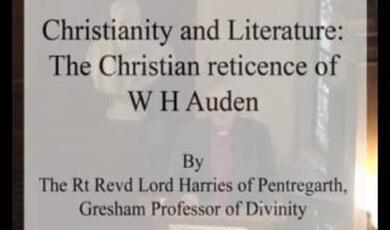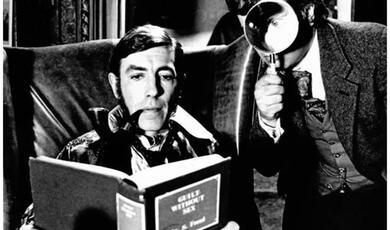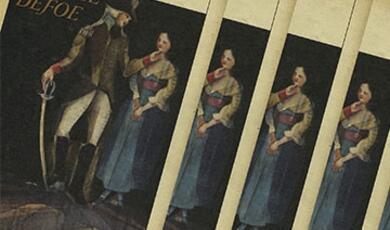Christmas Carols and Nostalgia
Share
- Details
- Transcript
- Audio
- Downloads
- Extra Reading
This lecture takes a trip down Christmas’s unique and emotionally complex memory lane via the Christmas Carol.
Carols paint a colourful picture of the Christmas story itself, frequently by adapting pre-existing material. The crowded stable at Bethlehem appears simultaneously ancient and modern, as do the carols that commemorate the Nativity. Christmas is indelibly associated with our own childhood experiences at home, in church, or out in the cold.
This lecture is also part of the series 'Music and Emotion' which can be found here.
Download Transcript
Like many other churches, at St Luke’s in Chelsea we open our Christmas Carol Service with ‘Once in royal David’s city’. And we begin with a lone voice singing the first verse entirely unaccompanied. Nostalgia is present on many levels. First, members of the choir and congregation will have memories of singing and hearing this Christmas hymn throughout their lives. For adult males, there may also be the nostalgic element of remembering how it felt to sing ‘Once in royal’ as a boy Treble (a specific physical sensation not replicated after the voice has broken). And many will listen regularly to the annual radio broadcast from King’s College, Cambridge on the afternoon of Christmas Eve. This year the nostalgia of the Festival of Nine Lessons and Carols from King’s will be heightened because in December 2020, SARS-CoV-2 restrictions prevented the live broadcasting of the King’s carol service, which had to be pre-recorded. There is nostalgia too in the King’s tradition of selecting a single chorister to sing the solo (a tradition begun by Boris Ord in the 1930s), right at the last moment (a tradition begun by David Willcocks in the mid-20th century). Indeed ‘Once in royal’ has opened the Christmas Eve afternoon service at King’s since the late-19th century (it was choirmaster Arthur Mann who began the tradition of the boys singing the first verse on their own). Moreover, our nostalgia may be focused on our reaction to the words of this delightful hymn, which were penned more than a century and a half ago. Mrs Alexander published her collection of Hymns for Little Children in 1848, and there is nostalgia in knowing that Fanny Alexander’s verses awake the inner child in many of us, as those verses have been doing for 173 years. The nostalgia inherent in singing or listening to ‘Once in royal David’s city’ may also be because of the passing of last year’s Christmas with all its (un)happy memories, as well as because the subject matter of Christ’s Nativity transports us back two millennia to a highly specific Middle-Eastern birth, but one that has resulted in many and varied Christmas memories for Christians and non-Christians alike.
Christmas carols are by their nature nostalgic. Their subject is an event that happened a long time ago in a world that we may believe to have been simpler, more earthy, and less dependent on technology (although technology was central to Jesus’ life as the son of a carpenter; what we really mean is that Joseph didn’t build furniture designed on a laptop).
Even the Holy Family’s trek from Nazareth to Bethlehem in order to be taxed is tinged with nostalgia since the reason for the journey itself was because Jesus ‘was of the house and lineage of David’ (from Chapter 2 of the Gospel according to St Luke in the King James Bible). So we look back 3,000 years to David’s rule as King of Israel & Judah and 2,000 years to the birth of Christ (27 or 42 generations later according to the Gospels of St Matthew and St Luke respectively). And in looking back all that way, we also look to our own childhood and – if we are old enough and fortunate enough – to births and childhoods of children and grandchildren.
The name of the ‘little town’ of Bethlehem conjures up nostalgia all of its own, not least through the words of Bishop Phillips Brooks. Before he became a bishop, Revd Brooks was Rector of the Church of the Holy Trinity in Philadelphia. Brooks took a sabbatical and travelled to Palestine, where he attended an overnight service at the Church of the Nativity in Bethlehem on Christmas Eve of 1865. As Brooks wrote:
I remember especially on Christmas Eve, when I was standing in the old church at Bethlehem, close to the spot where Jesus was born, when the whole church was ringing hour after hour with the splendid hymns of praise to God, how again and again it seemed as if I could hear voices that I knew well, telling each other of the ‘Wonderful night’ of the Saviour’s birth, as I had heard them a year before.
Brooks experienced gospel nostalgia just from being in Bethlehem and musing on the birth of Christ. But he also experienced nostalgia for the American children in his Sunday School back in Philadelphia whose voices he still carried with him in his memory. And so he wrote the words of a hymn:
O little town of Bethlehem, how still we see the lie. Above thy deep and dreamless sleep the silent stars go by. Yet in thy dark streets shineth, the everlasting light;
The hopes and fears of all the years are met in thee tonight.
The hymn’s present tense vividly conjures up a feeling of nostalgia. More than that, the hymn itself wasn’t written as Brooks gazed out over the little town of Bethlehem, but almost three years later when Brooks was back in America with his beloved Sunday School children, nostalgically relating the details of his visit to the Holy Land. Brooks’s organist wrote a tune for the hymn, but that was replaced for British congregations with a folk tune unearthed by Ralph Vaughan Williams for publication in the English Hymnal in 1906. Again, many levels of nostalgia are inherent in this gem of a carol, right down to its now-common tune (‘Forest Green’). The man who sang the tune to Vaughan Williams in 1903 lived in the village of Forest Green, near Leith Hill in Surrey, where the young Vaughan Williams had grown up.
The use of folk tunes within the liturgy was one of the most significant and long-lasting gifts of the English Hymnal. Given the nostalgic narrative of many Christmas hymns, to delve back into a country’s musical heritage to find an appropriate tune makes sense. Admittedly, close scrutiny might question whether the use of a melody whose original Tudor words celebrate the exploits of a promiscuous woman should be fitted to a poetic cradle scene written by a Scottish 19th-century businessman. William Dix was the manager of a marine insurance company in Glasgow, and his three-verse Christmas hymn ‘What child is this?’ was written in 1865 and published shortly afterwards in the first volume of Bramley & Stainer’s Christmas Carols New and Old. The 16th-century tune, widely known as ‘Greensleeves’, was harmonised by John Stainer for the project. It seems that Vaughan Williams did not regard the mixture of borderline lascivious poetry with a Nativity scene appropriate for inclusion in the English Hymnal, although the touching carol and its nostalgic tune had spread to America by the end of the 19th century and thereafter featured in many other English publications too. By contrast, a distinctly un-nostalgic use of Greensleeves is to the New Year carol ‘The old year now away is fled’ as published in the Oxford Book of Carols in 1928, thereby showing that (the agnostic) Vaughan Williams had no objections to the tune being used for secular purposes, although the harmonization is not by Vaughan Williams but by his musical co-worker, Martin Shaw.
Carols with colourful back stories make for nostalgic offerings, and The Boar’s Head Carol is just such an item:
Caput apri refero The head of the boar I bring,
resonens laudes domino while singing praises to the Lord.
The boris hed in hondes I brynge The boar’s head in hands I bring with garlondes gay and byrdes syngynge with garlands gay and birds singing;
I pray you all helpe me to synge I pray you all, help me to sing,
Qui estis in convivio Who are at the banquet.
The boris hede I understond The boar’s head I understand
ys cheff servyce in all this londe is chief service [dish] in all this land; wher so ever it may be fonde wheresoever it may be found
Servitur cum sinapio It is served with mustard.
The boris hede I dare well say The boar’s head I dare well say,
anon after the xijth day anon [immediately] after the 12th day, he taketh his leve and goth away he taketh his leave and goeth away: Exivit tunc de patria It has then left the country.
The opening Latin couplet is bracketed and described as ‘fote’ (foot) – in other words, a burden (refrain) that is heard at the beginning and after each of the three verses. During the reign of Edward II (1307 - 27), boar could be hunted from Christmas to Candlemas (2 February), hence why boar was the Christmastide meat of choice. While the Procession of The Boar’s Head is closely associated with The Queen’s College in Oxford, a boar’s head was also used as a decoration at Oxford’s Magdalen College in the Christmas of 1488. The custom of eating boar on Christmas day died out with the Tudors. When King James VI of Scotland succeeded Queen Elizabeth in 1603, the newly-designated James I of England banned the eating of boar at court – swine meat wasn’t eaten in Scotland. The wild boar became extinct in the 17th century (is it possible to be gastronomically nostalgic?), and the arrival of turkey from the New World started the custom that survives today.
The boar’s head celebrations were a medieval creation. A student who was studying at Queen’s College (founded in 1341 during the reign of Edward III as the ‘Hall of the Queen’s Scholars at Oxford’), was walking across Shotover Common on his way to attend a church service in the village of Horspath. A wild boar ran towards our hero, who killed the swine by thrusting a book containing the works of the ancient Greek philosopher Aristotle down the boar’s throat, apparently to the accompaniment of the veraciously redundant cry: Graecum est! – ‘It’s Greek!’. Having decapitated the hapless animal, the student went to Mass and left the boar’s head on a staff in the church porch; thereafter the young scholar took the boar’s head back to college where the custom began of singing The Boar’s Head Carol in procession before dinner. The version of The Boar’s Head Carol performed at Queen’s has a third verse that is place-specific:
Our steward hath provided this In honour of the King of Bliss, Which on this day to be servèd is
In Reginensi Atrio [In Queen’s Hall].
The Boar’s Head Carol has the distinction of being the earliest extant printed Christmas carol. It survives on a single leaf printed in London in 1521 by England’s first typographer, Jan van Wynken of Woerth (who died in the second half of 1534 or the first fortnight of 1535). Born either in Woerth-sur-Sauer in Alsace in Eastern France or Wörth am Rhein near Karlsruhe in South-Western Germany, Wynken was the first printer in England to print musical notation (in 1495), the first printer to set up shop in London’s Fleet Street (‘at the sign of the sun’ in late 1500 or early 1501), and the first printer in England to use italic type (in 1524, almost a quarter of a century after its development in Italy by Aldus Manutius of Venice). Fortunately, because Wynken’s single surviving carol leaf was the last page in the book, it contains the colophon (literally ‘finishing touch’), which is a mine of information:
“Thus endeth the Christmasse carolles newely enprinted at London in the fletestrete at the sygne of the sonne by Wynkyn de Worde. The yere of our lord, M.D.xxi.”
It is certainly possible to be nostalgic for the lack of survival of a book such as this.
One of the most oft-repeated stories surrounding a Christmas carol concerns ‘Silent night’. Strangely, ‘Silent night’ didn’t make it into any of the various editions of Hymns Ancient & Modern, neither into the English Hymnal, nor into the Oxford Book of Carols. Indeed, none of the English carol books had included it. Yet it was well known enough to feature in stories told about the Christmas Truce of 1914 at the start of the First World War. The song may not have been sung together by British and German troops (each in their own language) on either side of no-man’s-land. But the carol was deemed well enough known on both sides of the divide for the heart-warming story to be credible.
By the end of the First World War, ‘Stille nacht’ was about to celebrate its one hundredth birthday. In 1815, the young Austrian Joseph Mohr (1792 - 1848) was ordained priest in Salzburg. In the following year Mohr was sent to minister at a remote church in Mariapfarr, 70 miles away. It was in this Alpine retreat that Mohr wrote the words of the carol ‘Stille Nacht, heilige Nacht’, with its references to a landscape abundant with calm, quiet, and darkness. In 1817, Mohr was transferred to a curacy at St Nikolaus, Oberndorf bei Salzburg, where he became friends with the assistant organist Franz Gruber (1787 - 1863).
In the following year, Gruber set Mohr’s words to music, and the carol received its first performance at the midnight service on Christmas Eve of 1818 to the accompaniment of a guitar – a local custom at the time. Four years previously, the Austrian composer Franz Schubert had written his song ‘Gretchen am Spinnrade’ (‘Gretchen at the Spinning Wheel’) with its iconic revolving accompanimental figuration; there is something of this figuration in Gruber’s ‘Silent night’ accompaniment. But Gruber is unlikely to have known Schubert’s song, which was written 200 miles away and not published until 1821. Nevertheless, both the words and the music of ‘Stille Nacht’ are of that time and place.
The popular myth is that ‘Silent night’ was written by Gruber in a hurry on Christmas Eve because the organ in St Nicholas’s had broken down. It’s easy to see why this fable emerged, since the organ builder, Karl Mauracher (1789 - 1844), was indeed involved in the history of ‘Silent night’. But only by virtue of the fact that while on a routine visit to Oberndorf, Mauracher heard the carol and liked it. So he took a copy with him and touted it around. For this act of dissemination, a portrait of Mauracher was commemorated on an Austrian €0,62 postage stamp in 2011. Quite rightly, the same honour wasn’t accorded the Strasser Family singers who performed ‘Stille Nacht’ in Leipzig just before Christmas in 1832, and misleadingly billed it as a Tyrolean folk carol. That said, this performance directly resulted in the carol’s publication. By the late 1850s the carol had been translated into English by Emily Elliott (1836 - 97) for St Mark’s, Brighton – as ‘Stilly Night, Holy Night!’ – and by Rev.
John Freeman Young (1820 - 85), who was working at Trinity Church, New York City. Freeman Young was on his way to becoming Bishop of Florida, and it’s his translation that is best known these days:
Silent night! Holy night! All is calm, all is bright,
Round yon Virgin Mother and Child! Holy Infant, so tender and mild, Sleep in heavenly peace!
Sleep in heavenly peace!
In March 2011, UNESCO declared ‘Silent night’ an Intangible Cultural Heritage. To lovers of this Austrian classic, the wrong that was its omission from many of the leading carol books of the late-19th and 20th centuries has now been righted.
The earliest surviving Christmas carol in English for which music survives is ‘Lullay, lullay – As I lay on Yule’s Night’. The text itself promotes nostalgia:
lolay [lolay lolay lolay Lullay, lullay, lullay, lullay,
my deere moder] lolay my dear mother, lullay.
as ylay on yole is nyght As I lay on Yule’s Night,
alone in my lon[gyng] alone in my longing,
my thoght y sawe a well fayr sight I thought I saw a well fair sight: a may hir child
rokyng a maid her child rocking.
lolay Lullay etc.
This is an epic carol and, based on the dialect of its text, it hails from the East Midlands. Substantial though this carol is in terms of its length, its musical construction is modest, comprising a short Aeolian melody with a mere seven-note range – simple stuff, and hauntingly beautiful with it. The carol is picturesque. The first verse sees the poet lying in bed on Christmas night. As his imagination wanders, he conjures up the image of a young woman rocking her new-born baby to sleep – the young woman is Mary and the infant is Jesus. From the second verse onwards, the drama is played out in the mind’s eye of the poet. Mary tries to bed Jesus down, but without singing to him. Jesus registers his disapproval.
Specifically, Jesus asks that Mary sing him a song about himself, as other mothers do to their children. Mary readily acquiesces, but maintains that, apart from being told by the angel Gabriel that she was to give birth to the Messiah, she knows very little (never mind that some might think that was quite a lot). Mary recounts to Jesus how she gave birth painlessly on Midwinter Night and how the shepherds on the wold heard angels singing of the glorious birth. Jesus then takes over, and foretells the events of his life from the visit of the three kings after twelve days, through his encounter with Simeon on the 40th day of his incarnation, to being found teaching in the temple when he will be 12 years old. Then, verse by verse, Jesus tells of the events of his adult life including his baptism, temptation by Satan, the gathering of the disciples, and ultimately his Crucifixion and Resurrection. At the final verse we draw back to see the poet in a holiday haze, intent on convincing us that his nostalgic Christmas vision was real:
serteynly this sight I say Certainly this sight I saw,
this song I herde sing this song I heard sung,
als I lay this yoolis day as I lay on Christmas Day
alon in my longing alone in my longing.
It’s difficult to be certain, but it seems that ‘Lullay, lullay – As I lay on Yule’s Night’ dates from the mid-14th century, though with the possibility that verses 16 to 36 (the ‘intolerably long reply by Christ to his mother’ as Eric Dobson put it in 1979) were added a few years later. However, it’s also possible that the 37-verse version was the original, and that Dobson had some like-minded 14th-century predecessors who lopped the carol down to 16 verses. To be fair to the late Professor Dobson, this is unlikely given that the verses of the second half of the full text fit the tune less well than those of the carol’s first half. ‘Lullay, lullay – As I lay on Yule’s Night’ is a proper Christmas carol. It’s a stanzaic song with a burden that deals with a Christmas theme. But by the time that the late-medieval carol emerged, fully-formed in all its sophisticated glory at the beginning of the following century, some changes had occurred. First, the musical settings were usually polyphonic rather than unaccompanied melodies. And secondly, the (most usually) four-line stanzas had a short fourth line which rhymed with the burden that immediately followed. The verses of ‘Lullay, lullay – As I lay on Yule’s Night’ do indeed comprise four lines each, but the burden remains unconnected from the rhyme scheme of the verses, except in the case of the very last verse. This is no accident, and brings the carol to a satisfying conclusion.
Although the carol was possibly written as early as 1350, the earliest surviving source of ‘Lullay, lullay – As I lay on Yule’s Night’ is dated 1372. The words of the carol are found near the beginning of a manuscript kept in the National Library of Scotland in Edinburgh (catalogued as Advocates 18.7.21). Known as ‘John Grimestone’s Commonplace Book’ it comprises 143 alphabetically-arranged topics, and was copied cum magna sollicitudine (‘with great care’) by John Grimestone, a Franciscan friar probably working in South Lincolnshire. The earliest extant version of the carol’s tune dates from perhaps a quarter of a century later than the earliest source of the words, and getting on for half a century after the composition of the carol itself. The entire tune comprises 54 notes and covers an area of just 14 x 5 centimetres within Additional Manuscript 5943 in Cambridge University Library. The diminutive two lines of carol material appear towards the end of a dozen folios of music manuscript paper, which themselves appear towards the end of a manuscript comprising almost 200 pages of mostly sermonial matter. Part of the manuscript contains tables of eclipses, starting with the year 1415, at which time the manuscript still belonged to its compiler, Thomas Turk. In 1395, Turk had been appointed a Fellow of the recently-founded Winchester College, and the electic mix of material within the manuscript is explained by its provenance. Interestingly, all the musical notation in Turk’s book is in the same hand apart from that of our nostalgic carol ‘Lullay, lullay – As I lay on Yule’s Night’, which is in a second, less extrovert hand. The appearance of the musical notation throughout the manuscript is modern for its time, using as it does ‘void’ rather than ‘black’ notation. So the carol has nostalgic subject matter (the events of Christ’s life as well as the poet’s nostalgic reverie) and the carol is committed to paper sometime after its composition – this carol had legs, at least according to the nostalgic copyist.
© Professor Summerly 2021
Further Reading
Hugh Keyte & Andrew Parrott (eds) The New Oxford Book of Carols (OUP, 1992) Ian Bradley, The Daily Telegraph Book of Carols (Continuum, 2006)
Mark Connely Christmas – A History (I. B. Tauris, 2012)
Further Listening
Coope, Boyes & Simpson Voices at the Door – Midwinter Songs and Carols CD (No Masters, NMCD25, 2006)
Jeremy Summerly A Cause for Caroling – A celebration of the Christmas Carol in England
2 CDs (BBC Worldwide, 2014)
The Choir of King’s College, Cambridge 100 Years of Nine Lessons & Carols
2 CDs (KGS0033, 2018)
Further Reading
Hugh Keyte & Andrew Parrott (eds) The New Oxford Book of Carols (OUP, 1992) Ian Bradley, The Daily Telegraph Book of Carols (Continuum, 2006)
Mark Connely Christmas – A History (I. B. Tauris, 2012)
Further Listening
Coope, Boyes & Simpson Voices at the Door – Midwinter Songs and Carols CD (No Masters, NMCD25, 2006)
Jeremy Summerly A Cause for Caroling – A celebration of the Christmas Carol in England
2 CDs (BBC Worldwide, 2014)
The Choir of King’s College, Cambridge 100 Years of Nine Lessons & Carols
2 CDs (KGS0033, 2018)
Part of:
This event was on Thu, 09 Dec 2021
Support Gresham
Gresham College has offered an outstanding education to the public free of charge for over 400 years. Today, Gresham plays an important role in fostering a love of learning and a greater understanding of ourselves and the world around us. Your donation will help to widen our reach and to broaden our audience, allowing more people to benefit from a high-quality education from some of the brightest minds.


 Login
Login







